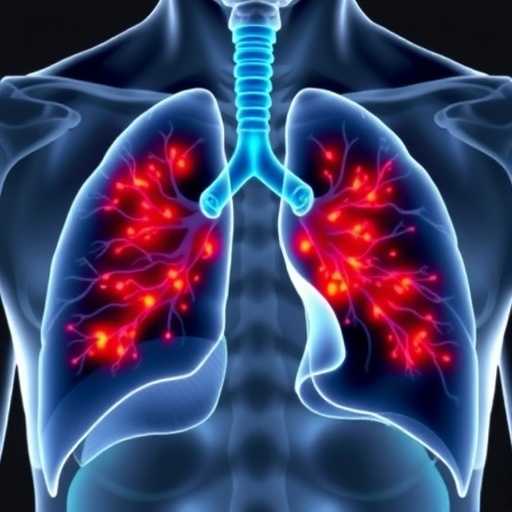In a groundbreaking study published in Nature Communications, a team of researchers has unveiled compelling insights into how common genetic variations influence human lung imaging phenotypes. This pivotal work marks a significant advancement in our understanding of the genetic architecture underlying lung morphology and function, as captured through advanced imaging techniques. By harnessing comprehensive genomic data alongside state-of-the-art imaging analysis, the study illuminates the complex interplay between our genetic blueprint and the physical characteristics of lung tissue—findings that hold immense promise for personalized medicine and early disease detection.
The human lung is an intricate organ whose structure and function are critical to respiratory health. Variations in lung imaging phenotypes—quantitative traits derived from imaging modalities such as computed tomography (CT)—can reflect subtle anatomical and functional differences among individuals, some of which may predispose them to respiratory illnesses. Until now, the extent to which common genetic variants contribute to these phenotypic differences remained poorly understood, with prior efforts hampered by limited sample sizes and insufficient resolution of imaging data. The current research addresses these challenges by integrating large-scale population genetics with high-resolution lung imaging, unveiling new dimensions of lung biology.
Central to the study’s methodology was the utilization of a massive dataset comprising thousands of participants, each subjected to comprehensive lung imaging alongside genome-wide genotyping. Employing advanced computational approaches, the team extracted a rich spectrum of quantitative phenotypes from lung images, including measurements that describe lung volume, airway architecture, and parenchymal texture. These phenotypic traits were then used as quantitative traits in genome-wide association studies (GWAS), seeking to pinpoint genetic loci that statistically correlate with variations in lung structure and function.
The findings revealed numerous novel genetic loci associated with distinct imaging-derived lung phenotypes, many of which map to genes previously implicated in lung development and respiratory disease pathogenesis. Notably, several variants demonstrated pleiotropic effects, influencing multiple imaging traits simultaneously, suggesting shared genetic regulatory mechanisms. This multiplicity underscores the complexity of lung morphology regulation, driven by a network of genetic interactions that transcend individual traits.
One of the remarkable aspects of the study is its focus on common genetic variants—those found frequently across populations—in contrast to the rarer mutations often spotlighted in genetic disease studies. By emphasizing these widespread variants, the research sheds light on subtle yet collectively significant genetic influences that shape lung architecture in the general population, offering a nuanced perspective that bridges basic biology with clinical relevance.
The research also explored the genetic correlations between lung imaging phenotypes and various pulmonary diseases, including chronic obstructive pulmonary disease (COPD) and asthma. Results indicate that several genetic loci associated with lung traits show overlap with loci implicated in these diseases, highlighting potential genetic pathways that mediate disease susceptibility through anatomical and functional lung changes detectable by imaging. This convergence provides a genetic and phenotypic framework to better predict and understand respiratory disease risk.
Moreover, the investigators employed sophisticated statistical methods to disentangle the genetic contributions from environmental confounders, such as smoking status and air pollution exposure, ensuring that the associations identified reflect genuine biological influences. This rigorous analytical approach enhances confidence in the robustness and validity of the genetic signals identified.
The practical applications of this research are far-reaching. By integrating genetic data with lung imaging phenotypes, clinicians may soon be able to stratify patients based on inherited lung structural characteristics, facilitating early detection of individuals at risk for respiratory diseases before clinical symptoms emerge. Furthermore, understanding the genetic underpinnings may inform new therapeutic targets designed to modulate lung structure and function, potentially altering disease trajectories.
Beyond clinical implications, this study provides a template for the integration of imaging phenotypes as quantitative endophenotypes in genetic research. Such high-dimensional phenotypes, derived from sophisticated imaging technologies, offer a powerful complement to traditional clinical endpoints, enabling more precise mapping of genetic influence on complex organs like the lung.
The research team emphasizes the value of multidisciplinary collaboration, combining expertise in pulmonary medicine, genetics, radiology, and computational biology to achieve these insights. The synergy of these fields permits nuanced interpretation of both genetic data and imaging traits, driving forward the frontier of respiratory genomics.
Intriguingly, the study also uncovered genetic variants that influence regional lung characteristics, providing a granular view of how different lung segments may be differentially affected by genetic factors. This regional specificity opens avenues for further research into localized lung pathophysiology and its genetic determinants.
While the study primarily focused on adult populations, the methodologies and findings set the stage for analogous investigations in pediatric cohorts, which could elucidate developmental aspects of lung genetics and inform early-life interventions.
The authors acknowledge limitations, including the predominance of certain ancestries in the cohort, urging future studies to include more diverse populations to enhance the generalizability of results. Additionally, integrating multi-omics layers such as transcriptomics and epigenomics with imaging and genomics remains a promising next step to unravel mechanistic pathways.
In summary, this landmark study richly enhances our comprehension of how common genetic variation sculpts the human lung’s intricate anatomy as seen through imaging phenotypes. By marrying genomics with cutting-edge imaging, it paves the way for next-generation respiratory medicine where genetic insights guide personalized diagnosis, prognosis, and treatment. As our understanding deepens, so too does the potential to transform respiratory healthcare through precision approaches tailored to each individual’s unique genetic and phenotypic profile.
Subject of Research: Influence of common genetic variation on human lung imaging phenotypes
Article Title: Common genetic variation influencing the human lung imaging phenotypes
Article References:
Zhu, M., Du, L., Shi, L. et al. Common genetic variation influencing the human lung imaging phenotypes. Nat Commun 16, 9551 (2025). https://doi.org/10.1038/s41467-025-64571-z
Image Credits: AI Generated
Tags: advanced imaging techniques in geneticsanatomical differences in lung tissuecomplex interplay of genetics and lung anatomyearly disease detection through imaginggenetic variations in lung imaging traitsgenomic data and lung phenotypeshigh-resolution imaging in lung researchhuman lung morphology and functionlarge-scale population genetics studiespersonalized medicine and lung healthquantitative traits from lung imagingrespiratory health and genetic factors





